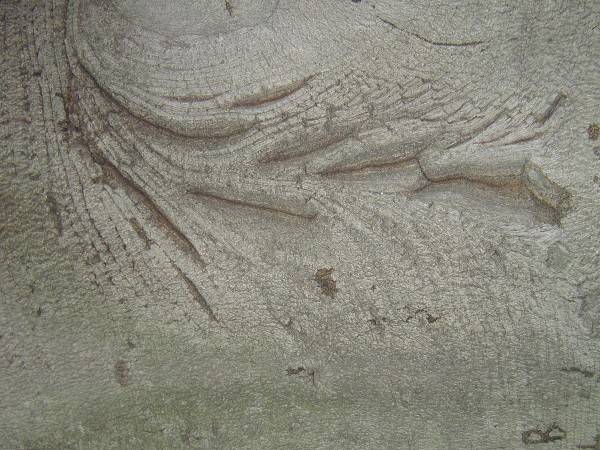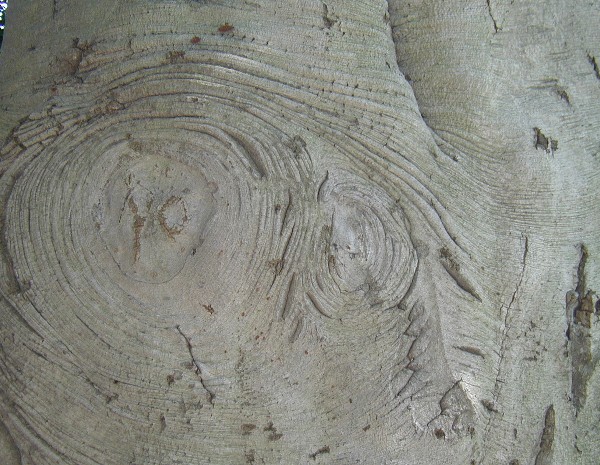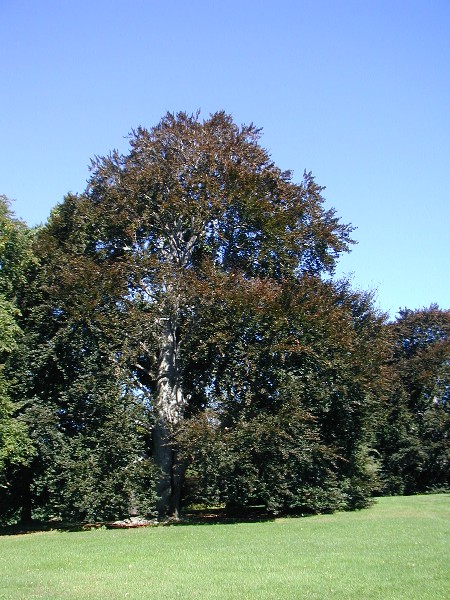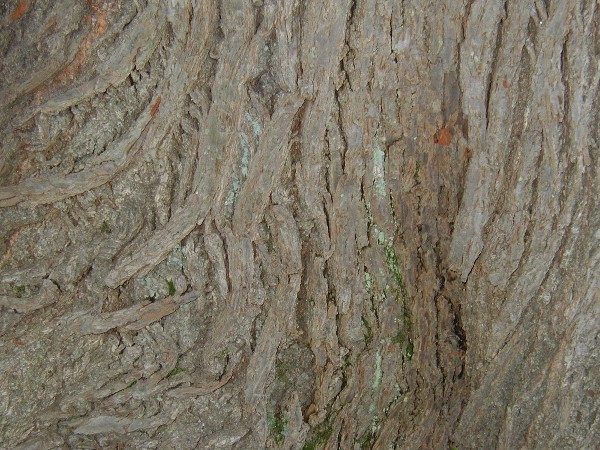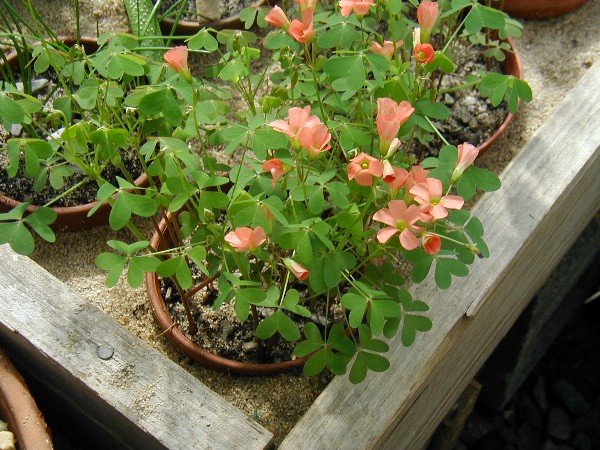
I have a greenhouse. Briefly: it is an 8 ft. by 18 ft. lean-to, glass to ground with a twin-wall roof. It is what is termed a cool house, one that's only heated to 50° Fahrenheit. I focus primarily on bulbs (a category of plants I already adore) and especially those which flower in winter. I force the typical spring-blooming, winter-hardy, garden-familiar tulips, daffodils, hyacinths which I've already mentioned. As well, the winter-bloom bulbs of the South African Cape region are a joy and a delight. Lachenalia and oxalis are two easily grown bulbs with numerous species to offer diversity within their genera. They're modest in size, which means I can cram lots of pots into my limited space. And their needs are modest too. After a summer-long dry dormant period bulbs are re-potted in September into a gritty, quick-draining mix. One thorough watering, then nothing more until there are signs of growth. Most of the pots are plunged in sand, kept moist. This provides more even moisture levels when the plants are in growth. It also means that plants may run their questing roots out the pots' drainage holes. Not an issue for the growth, only for bringing them into the house to show them off.

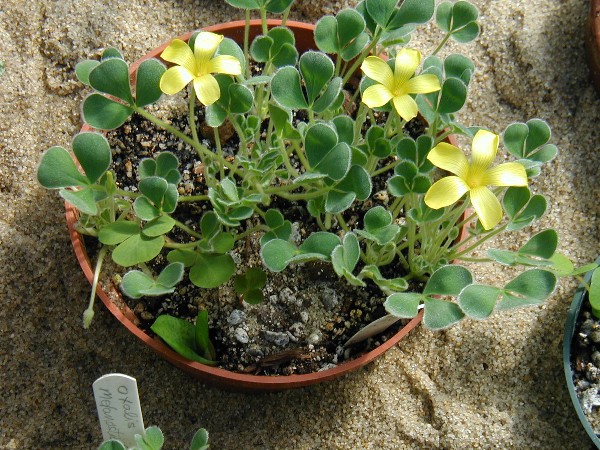
I've been zipping in and out of the Bronx. To be accurate, at 83 miles one way it's not exactly a zip. However with the Buried Treasures: The Nature and Art of Bulbs exhibition now open at The New York Botanical Garden I've been there numerous times: for final stages of the exhibition's installation, a press preview, the public opening, and curator-led tours. And on my way home include a little visit to Wave Hill . A quiet stroll around the grounds is a good way to decompress before the long drive home.
In addition to potting up daffodils, hyacinths, and tulips for early flowers indoors while it is still winter outside I like to pot some up in containers for use when they're typical in bloom. One of the best, I think, is for display in the window boxes on my tool shed.
When the tool shed was ordered, I specified that the window boxes should be made to hold a pre-made fiberglass liner. This mades it easy to swap them out as the seasons change, and also significantly reduces the rot and decay that wet soil causes when in close contact with wood.
The tulip's flowers are soft apricot-orange with light purple feathering and the hyacinth has salmon orange flowers. Notice that there is space towards the front of the window box. Possibly next spring I'll plant some violas, minature pansies. 'Jolly Joker' has orange and purple flowers, and they might be rather nice. Or maybe I'll pot up some grape hyacinths, Muscari armeniacum, this fall. We'll see.
Since I'm not forcing these bulbs into early bloom I'll leave them outdoors to begin their rooting, just as the same bulbs would behave if planted in the ground. But the relatively limited soil of a window box freezes much more severely than the garden will. So at some point I'll need to bring the window boxes into shelter, cold enough to keep them from premature flowering. Mice also move into the garage for the winter, and think that pots and window boxes of tulips and hyacinths make yummy snacks.
Daffodils offer the easiest of bulbs for forcing. Choose tazetta or paperwhite daffodils, and they're ready to bloom with no chilling period whatsoever. Native to the Mediterranean region, these daffodils are suitable for gardens in regions such as southern California that have a similar climate. They freeze out and die in cold winter areas. For indoor cultivation, paperwhite daffodils are almost as easy as "just add water."
Do not refrigerate paperwhite daffodils. Store extra bulbs in a brown paper bag or a mesh sack at room temperature. When ready to grow the bulbs just place them in a water-tight container with a few inches of pebbles, marbles, or similar material at the bottom. Set the bulbs on top, and add additional pebbles to just cover the shoulder of each bulb. This helps stabilize the bulbs and keep them from falling over. Add water to reach just below the bottom of the bulbs. Done. Place the container in a sunny window and wait for flowers, which will take 3 to 4 weeks. Once they've flowered, discard the bulbs. Having been forced with water the nutrients stored within the bulbs were consumed and not replenished. Further, paperwhite bulbs are not winter-hardy.
Cold-hardy daffodils may be coaxed into early bloom in much the same way as tulips and hyacinths. Just about any of the earlier flowering daffodils may be used for forcing. Keep in mind that the larger growing trumpet, large cup, and small cup daffodils will require larger pots than the daintier cyclamineus which are my favorites.
Daffodils are potted in a standard pot, one as tall as it is wide. Fill the container approximately a third of the way, using a light open potting mix as previously suggested. Tap the container on your workbench to lightly settle the potting medium. Scoop a shallow recess for each of the four bulb.
Add some more potting mix to barely cover the bulbs, and again tap the bottom of the container on your workbench to settle the soil. Carefully scoop a shallow hollow between each pair of daffodil bulbs you just planted, setting four more bulbs in place. Make one more hollow in the center, for a ninth bulb. No bulb should be set directly above a bulb in the first layer.
Finish filling the pot with planting mix, rap on the workbench to settle the soil, label, and water. With a standard pot and using this technique you've planted twice as many bulbs as otherwise. Remarkably, all the bulbs will flower at the same time and at the same height. Provide 14 to 16 weeks chilling / rooting period. Once pots are filled with roots and green shoots begin to appear it is time to bring the first pots to a sunny window. Flowers should open in approximately four weeks. If you planted multiple pots, bring in a couple every 10 days or two weeks for a sequence of bloom. If you have the space to keep the daffodil bulbs in vigorous growth after they flower, they may be planted into the garden when spring weather arrives and the ground thaws out.
Many tulips are just as easy to coax into early bloom as hyacinths. I prefer to use tulips that flower earlier in the season, as they are easier to coax into bloom than those that bloom in late spring. Further, I find short tulips more attractive in pots, especially since I don't use growth inhibitors as do commercial growers. One big advantage to forcing tulips into early bloom indoors is that the deer to not come indoors to eat them. And it takes dedicated effort to protect the tulips in the garden.
Earlier flowering, lower growing tulips are included the following categories: Cultivars of Tulipa kaufmanniana typically flower in early spring, at the same time as Crocus vernus and Chionodoxa, and grow 6- to 8-inches tall. Griegii tulips bloom in early mid-spring, together with grape hyacinths, Muscari armeniacum, and Grecian windflower, Anemone blanda, and - at 8- to 10-inches and taller - are a little larger. Fosteriana cultivars, also early mid-spring flowering, grow 12- to 18-inches tall. Single Early tulips flower in mid-spring with daffodils and hyacinths, and vary in height from 10- to 16-inches tall. Double Early tulips, which look like little peony flowers, also bloom in mid-spring and at 8- to 10- to 12-inches tall, are lower growing than many Single Early tulips.
One of my favorite tulips for forcing is 'Prinses Irene', now classified as a Triumph tulip. The flower is peach / apricot / orange, feathered with soft lilac purple, with a light but noticeable fragrance, and growing 12- to 14-inches tall.
Add some potting mix to barely cover the bulbs, then tap sharply on the workbench to settle the soil and allow the bulbs' noses to just show. Water well. Since it is raining today, I just put the pots outdoors. The cool temperatures we're experiencing are ideal for rooting. I'll leave the bulbs outdoors until truly chilly weather arrives, then bring the pots into the garage for the remainder of their 14 to 16 week rooting period. I'll plan on bringing the first pots indoors to a sunny window at the end of January, beginning of February, for flowers at the end of February or very early March.
Can't hardly wait!
It's time to fool Mother Nature. Here's the deal. Buy bulbs. Plant some in the garden. Plant some in pots. Have a preview of spring.
Let me explain. Bulbs we plant in the fall expect, nay require, a period of cold temperatures to initiate growth and flower in the spring. That's why tulips and daffodils and such have a difficult time of it in southern California. If they've been given a preliminary chilling by the vendor from whom they were purchased they'll flower the following spring. But not again after that, unless you dig them up and give them the necessary chilling again. And again, and again, every year. See, there are benefits to living where there's winter. Our bulbs naturally receive the requisite chilling. However, they do not necessarily need as much chilling as Mother Nature provides in say, New Jersey or Connecticut or Massachusetts. Fourteen weeks will do. So if you pot up certain bulbs in mid-October, provide cool but not freezing temperatures while they root, why, then you can have spring flowers indoors while it is still winter outdoors.
Hyacinths are one of my favorite bulbs for forcing. They are easy, they're reliable, and their fragrant flowers come in a range of colors from shades of blue to violet and wine purple, red to pink, salmon, yellow, and white. In addition to potting up in a soil-base or soilless mix, hyacinths may be brought into bloom perched in a special jar called a hyacinth glass, something that was discovered 230+ years ago.
If you choose to use a hyacinth forcing jar, choose a shorter, fatter, dumpy one. Tall, elegant jars topped with a top-heavy hyacinth in full bloom have a regrettable tendency to fall over. Very messy. Also, hyacinths that have been forced over water are worthless afterwards. Stored nutrients in the bulb have been consumed and were not replenished. Those bulbs potted up in soil or even a soilless mix (provided you fertilize now and again) may be planted in the garden once the ground has thawed, for a repeat performance is subsequent years.
Pots come in different shapes. A standard pot is as tall as it is wide. An 8-inch diameter standard pot is 8 inches tall. An azalea pan is 2/3 as tall as it is wide, so an 8-inch diameter pot is 6 inches tall. And a bulb pan is only half as tall as it is wide, 4 inches tall for an 8 inch diameter pan. I prefer the appearance of an azalea pan and tend to use plastic. They're less expensive and easier to come by in quantity.
Since the bulbs will have limited root run, use a loose, open potting mix. I use a peat-based soilless mix, adding some sand and orchid bark (clean, small size, dense bark used for potting orchids) at a 3:1:2 ratio. Thoroughly mix everything together, and then moisten with hot water (which is taken up better than cold or tepid water.) Take a clean pot and cover the drainage holes with pieces of crocking or some mesh landscape fabric to allow water to drain while retaining the soil. Fill the pot about half-way with the potting mix. Tap the pot on your workbench to settle the soil. Space the hyacinth bulbs in the pot to see how many you'll be using. I use six in an 8-inch diameter pot. Now take the bulbs out and scoop a little recess in which each one will nestle. If you force the bulbs down into the soil it will compact beneath the bulb. Roots will have a difficult time questing down into it. Instead, they'll lift the bulb out of the soil on stilt-like roots. Not good.
Add more potting medium to barely cover the hyacinth bulbs. Tap the pot on the work table again, to just settle the soil and allow the bulbs' noses to peek through. Remember to allow sufficient space for watering without splashing out.
Water, and label. Three months on I'll want to know if this pot is hyacinth or tulips or daffodils or whatever. And, since I'll be potting several different cultivars, which hyacinth. Good choices are bright rosy-pink 'Jan Bos', pansy-violet 'Ostara', pale pink 'Anna Marie', salmon-apricot 'Gipsy Queen', self-descriptive 'Pink Pearl', white 'Carnegie', soft blue 'Delft Blue', and dark blue 'Blue Jacket' and blue-violet 'Blue Magic'. Include the date when the bulbs were potted up, so you'll know when to bring them indoors for finishing into bloom.
Hyacinths need approximately 14 weeks at cool temperatures, 38- to 45-degrees Fahrenheit. If you splurged on pre-cooled bulbs you can shave two weeks off that time. I keep the pots in an attached, unheated garage. A friend had an old refrigerator used for soda and beer in the summer, pots of bulbs in the winter. Check periodically to see if the pots need a small drink of water. Once the roots are peeking out the drainage holes, and green shoots are showing above the soil you can bring them indoors to sunnier, warmer conditions for flowers in approximately three to four weeks. If you potted up several pots of hyacinths consider bringing them in at staggered intervals, 10 days or two weeks apart, for a sequence of bloom. Do it now, and enjoy fragrant hyacinths in flower in February.
UPDATE George Shakespear commented: "After reading your suggestions maybe I'll try forcing hyacinths again. I've gotten discouraged after a couple of years of mixed results. A few bulbs had perfect flowers, but others had flowers opening before the shoot was fully emerged. Maybe my refrigerator in the garage doesn't hold the right temperature for them. Or I was just unlucky."
Hyacinth flowers get "stuck in the neck" when the emerging shoots get too much light too soon. One technique is to make a cone of dark construction paper (remember the stuff we used to use in kindergarten?) like a dunce's cap and slip it over the shoot to elongate it as it begins to emerge. When removing this shading, it is important to expose the pale shoot to sunlight only gradually. If abruptly shifted from shade to sunny the leaves may be shocked and never green up properly.
A still day. No breeze has given them a push. Short days and chilly nights provide the cues for the abscission layer at the base of each leaf petiole to closed. Weakened, the leaves are falling unassisted.
I had hoped for another week or two, until the next full moon, but it was not to be. The polar express came sweeping down from Canada.
We're in good shape for this winter's firewood. When Mira, Steve, and the girls were here in early September Steve and Paul got three big trees down, standing dead that are ready to burn once split into stove wood. Paul cut a few more smaller standing deadwood, and today dropped another, of moderate size. Like everything, there's a learning curve to felling trees. By now, Paul is good at it.
Since we haven't had a frost it cannot be called Indian summer. Mild temperatures, just a breath of a breeze, with an achingly beautiful cerulean blue sky. Time for a picnic! I decided and swept Paul up into the event. Sandwiches and hard-boiled eggs, coleslaw and pickles, carrot and celery sticks, soda and cider and apples. I wanted more than a stroll onto the lawn or a saunter off to the Forest Deck. So we packed the little fabric cooler, two fabric folding chairs, a pair of binoculars and ourselves into the car for a less-than-15 minutes drive to Hoffman Park.
Once upon a time this was the farm of Albert and Joyce Hoffman. They lived here in the summer, renting the grazing out to farmers for so much per head of livestock. Today the 353 acre park, comprised of hardwood forest, grasslands, and 32 ponds of various sizes, is used for hiking and nature study, mountain biking and cross-country skiing, fishing and hunting.
Today is the day, here at last. It's the public opening of Buried Treasures at the New York Botanical Garden. Overcast skies for my drive in, clearing to sunshine and puffy clouds in the afternoon. NYBG as busy as I've ever seen it, so many people that as well as in the parking spaces cars were parked along the curb. Crowded groups of people walking across from the train station. I try to decide if damp weather would be better, for then perhaps people would be more likely to come indoors. No matter. It is what it is. And at 2:30 p.m. I'm upstairs in the rotunda outside the gallery, waiting for visitors.
At the end of the day there were only a handful of participants for the gallery tours I was ready to present. Ah well, it's the Saturday of the Columbus Day holiday weekend, with delightfully comfortable autumn weather. Difficult to compete with Chihuly and flowers. But there's three more months of opportunity for folks to visit the display. (And plant some bulbs in their own gardens too.)
I too spent some time out on the grounds, enjoying scads of flowers and the sunshine. So far we've not had a frost, leaving everything still in fine condition.
Notable for it's many beautiful gardens and self-guided nature trails surrounding a historic Colonial-Revival mansion and commonly referred to simply as the Frelinghuysen Arboretum, this 127 acre site is arguably New Jersey's premier public garden. Located at 53 East Hanover Avenue in Morristown and part of the Morris County Parks Department, its "proper" and formal name is the George Griswold Frelinghuysen Arboretum. I was here today presenting a lecture on Consider the Leaf: Foliage for Garden Design to the New Jersey Committee of the Garden Club of America.
I was invited to speak by the Garden Club of Englewood, New Jersey. Started in 1921, it has demonstrated a long-term commitment to civic involvement, conservation and environmental awareness, undertaking a diversity of projects from the installation of native plantings to the development of a small courtyard garden at Englewood’s Southeast Senior Center for Independent Living. The club helped to establish the Flat Rock Brook Nature Center in the 1970s and supported the center throughout the 1980s. Club members created a lush landscape in a former quarry at Flat Rock Brook, using only native trees, shrubs, grasses and wildflowers. The club received the Garden Club of America Founders Fund Award for this Backyard Habitat project in 1992. More recently, the Garden Club of Englewood has been involved in an effort to restore the American chestnut, Castanea dentata, to the grounds of the Tenafly Nature Center. Eighteen American chestnut seedlings were planted in 1997 and, with the club members help, a good proportion survived their first winters, animal predation, and disease.
Well attended, there wasn't an empty seat available, and the talk was well received by my audience. Lovely attention to detail on the part of the organizing committee - the arrangements on the tables were foliage, the various shades of darker greens harmonizing with the apple green tablecloths for the luncheon, the same apple green as the paper on which my handout was copied. As well as the lecture and luncheon, shrubs and bulbs which had been pre-ordered were available for pick-up. I had brought books for sale and autographing, and sold out.
After the event's conclusion I took a little time for a brief walk through the gardens adjacent to the Hagerty Education Center. Overcast and rather cool though the day might be, at least it was not raining.
I first read Tolkien's "Lord of the Rings" trilogy and "The Hobbit" a very long time ago. Was disappointed in the cartoon version. Enthralled with the movie trilogy. Except for the Ents. They were cartoon-y. From Tolkien's prose pictures I had (and have) a very clear image in my mind of what Ents were like.
What detail there is, once we learn to see what we look at.
There's less than a week to go. Buried Treasures: The Nature and Art of Bulbs will have its public opening in the gallery of the LuEsther T. Mertz Library of New York Botanical Garden next Saturday, 7 October. It may look frenzied, but the behind the scenes work is well in hand. Conservation has done its usual impeccable job of preparing the books for display. Just think of the stress it must place on the binding, to hold one of these volumes open, frozen in one position for three months. Sturdy clear plastic supports, barely visible hence non-distracting, do the job. Olga and her assistants are here in the thick of things.
The loose art: three drawings by Anne Ophelia Dowden, one by Kevin Nicolay, three on loan from Arader Gallery - are framed and hung. The checklists - illustrated brochures with case label text and information about each item, were delivered yesterday. Items are arranged in their proper case, measured, measure again, placement tweaked, adjusted, and fine-tuned. The heavy glass of the vitrine tops is shifted with large vacuum suction cups, a pair on each end. Safer, and avoids finger smudges. Two people are working on lighting. Last minute revisions to enlargements of a couple of engravings, adjusting / matching tonal qualities. Requisite attention to detail will result in an exhibition of the highest quality, our goal.
Suitable for the books, it's chilly in the gallery. In minutes I don't even notice, drawn into the whirlwind of effort. Three more days . . .
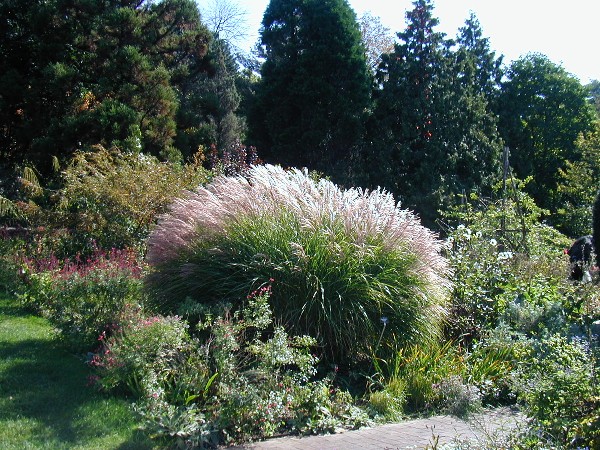
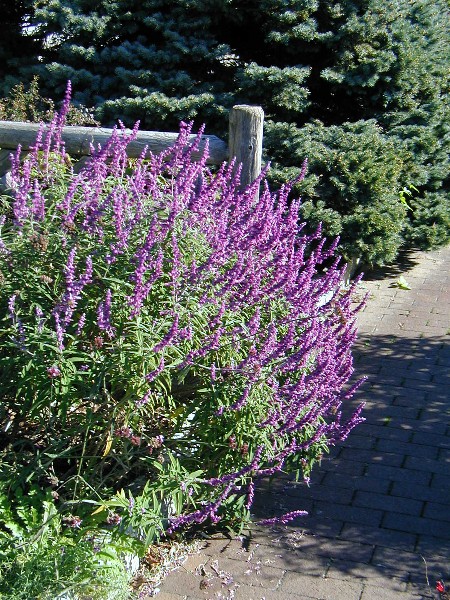

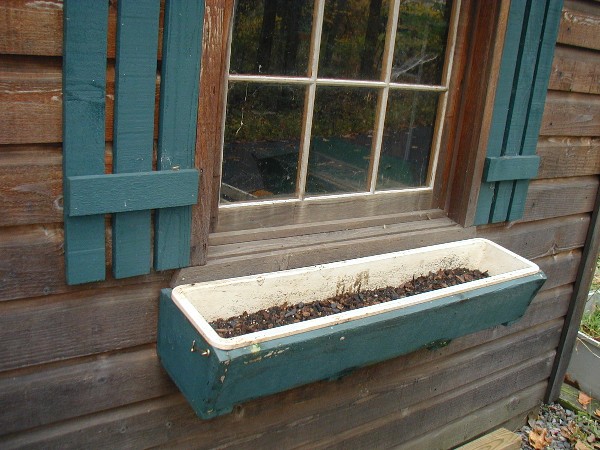
The insert has five large drainage holes, and the wooden shell has only a couple of struts across the bottom.
Screening over the holes keeps the potting soil in place while allowing water to drain freely. Bulbs do not like to be wet.
There are four groups of 3 tulips, interspersed with a single hyacinth bulb, repeated three times.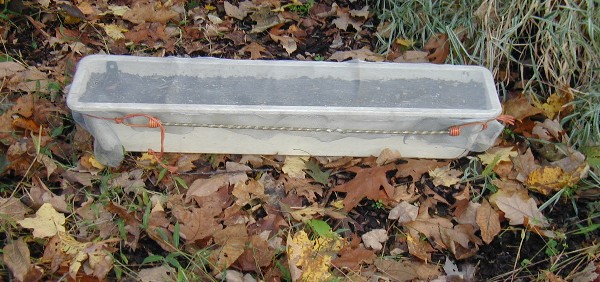
is held in place with baler twine and a bungie cord. This has worked well in previous winters.
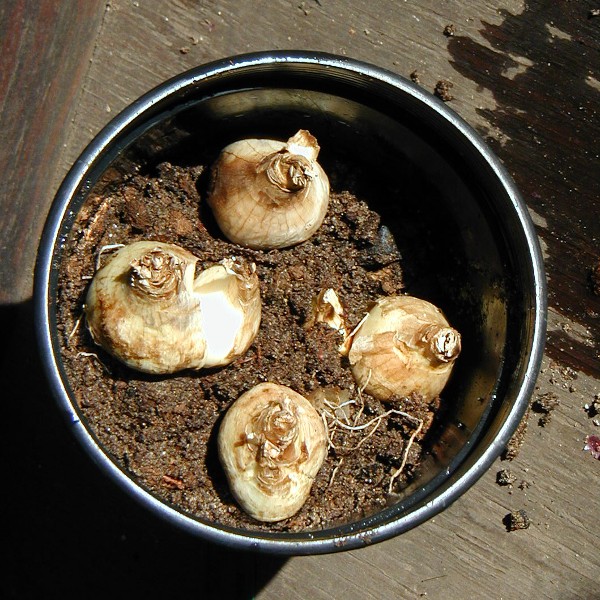
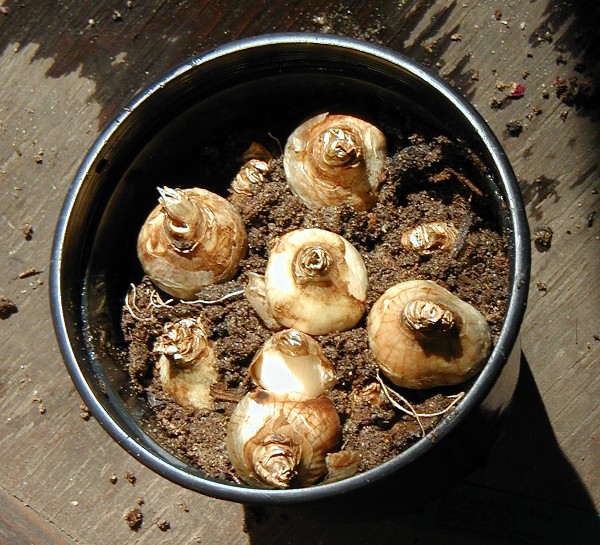
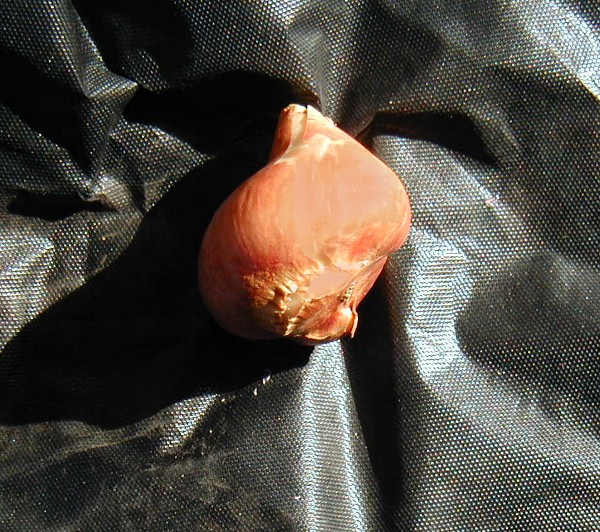
The first, lowest leaf on the tulip's stem appears on the bulb's flatter side.
A nicer appearance will be achieved by placing the tulip bulbs so their flatter side faces the rim of the pot,
resulting in a display a foliage rather than a glimpse of naked stems when the bulbs are in bloom.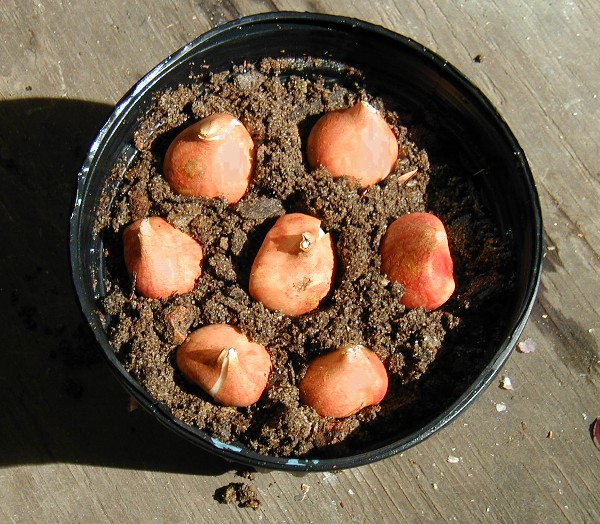
Scoop a small hollow in which to nestle each bulb.
While I could crowd in another one or two, maybe even three,
these 7 bulbs in an 8-inch azalea pan are sufficient to give me a very nice display.
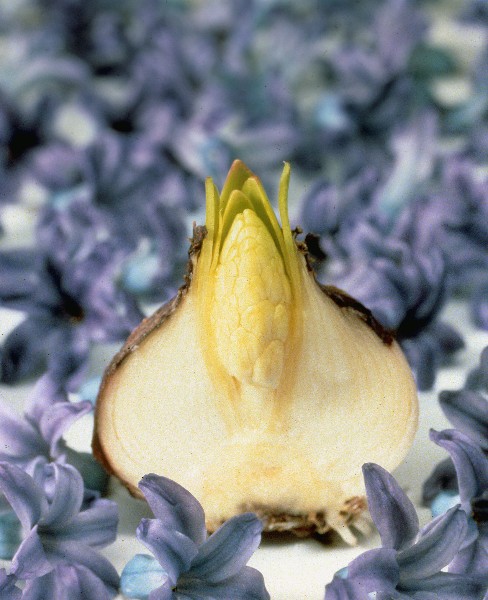
Image Courtesy of the Netherlands Flower Bulb Information Center
on display in the Buried Treasures: the Nature and Art of Bulbs exhibition
in the Gallery of the New York Botanical Garden's LuEsther T. Mertz Library, through 7 January, 2007.
Image Courtesy of the LuEsther T. Mertz Library, The New York Botanical Garden.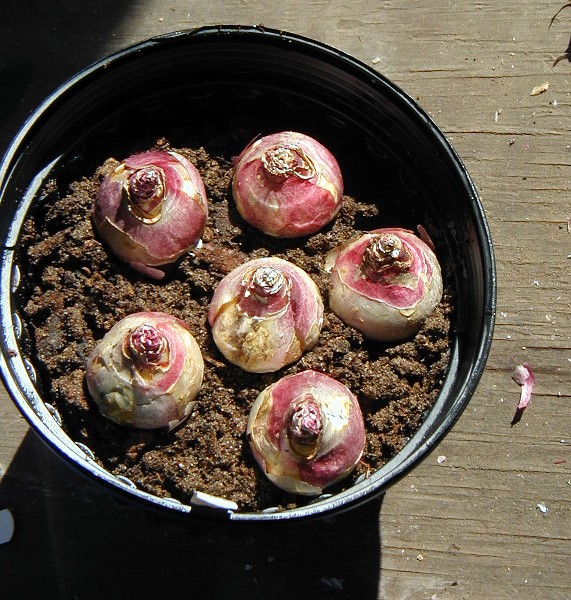
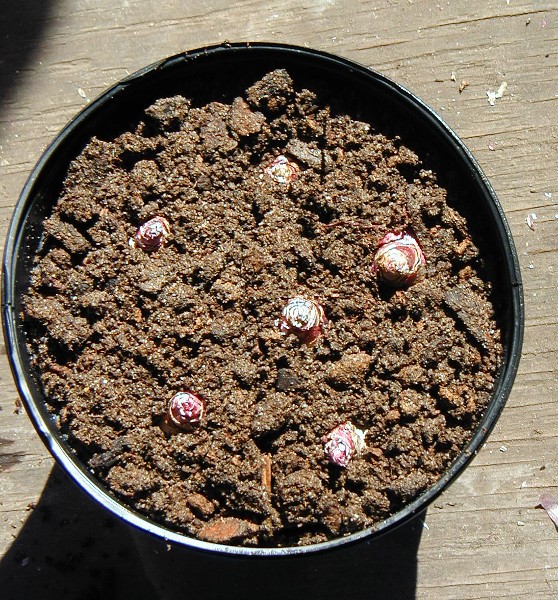
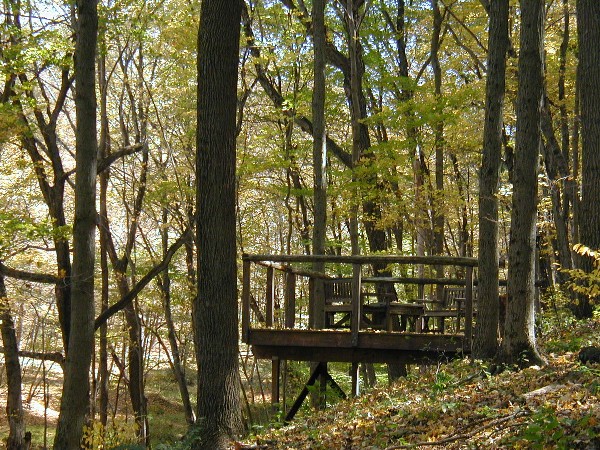
enough leaves have fallen to layer on the ground and on the Forest Deck.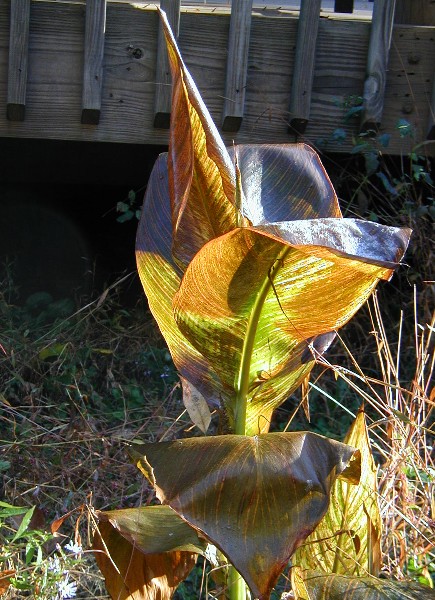

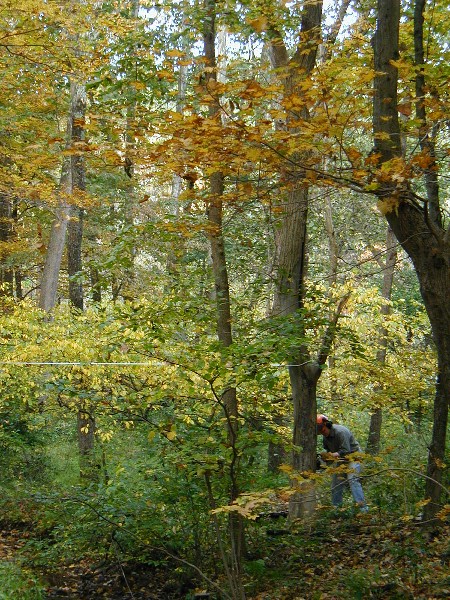
A deep notch cut out on that side, then a felling cut, higher on the opposite side.
Done well, the tree will break on a hinge of wood.

The wood is nice and solid, good firewood.
again when you split it, and at last when you burn it." There's still a lot of work to do -
cutting, moving, splitting, and stacking. There's also time before cold weather arrives.
We're in good shape for this winter's firewood.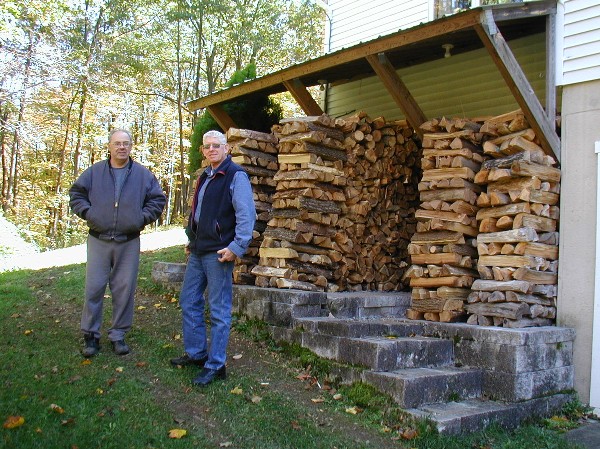

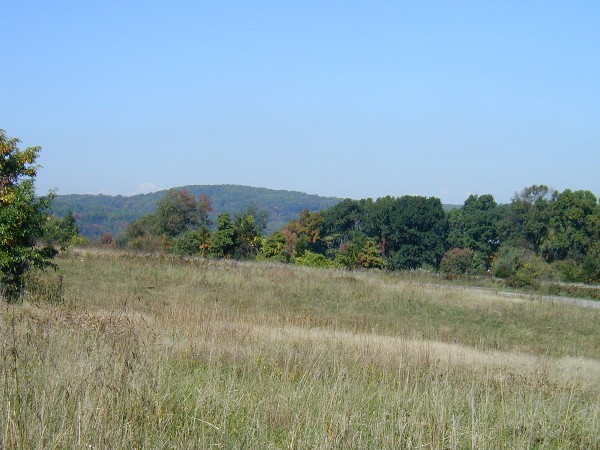
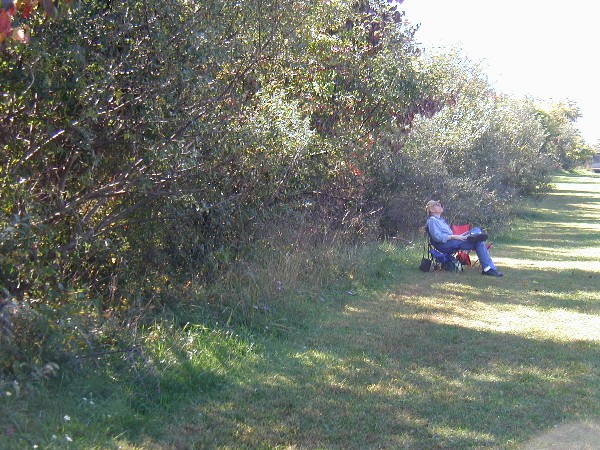
then set up our chairs in the shade of some hedgerow trees.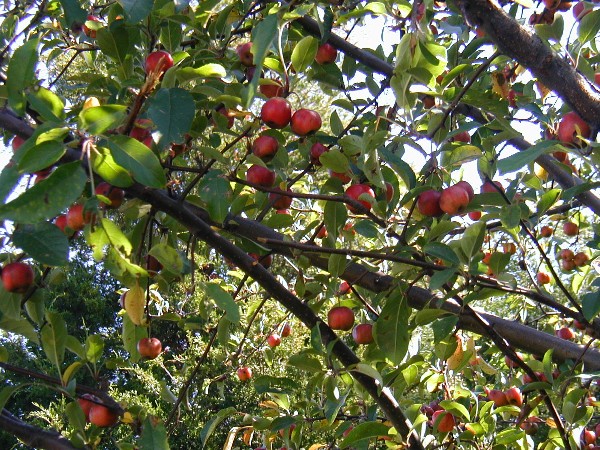
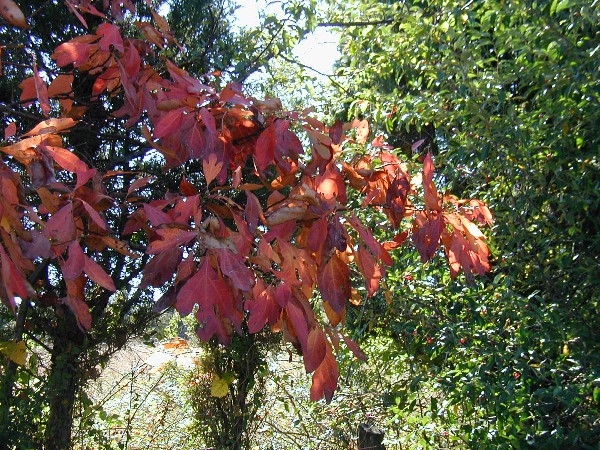



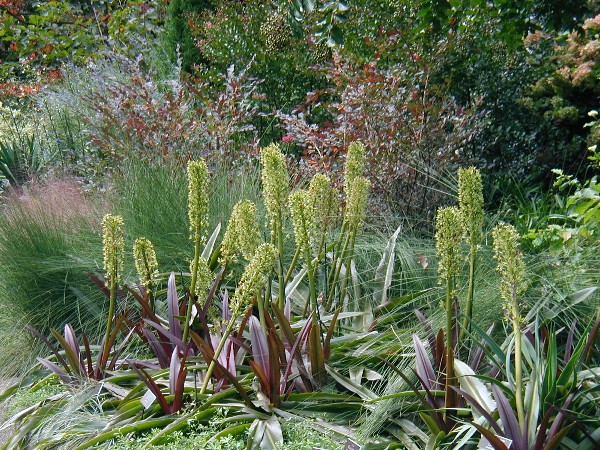
and around the corner from the Jane Watson Irwin perennial garden.
So sheltered is the area that these eucomis wintered over from last year.
(formerly Chrysanthemum nipponicum) brighten the cloudy October day with more flair than chrysanthemums.
Good thing the plants know who they are, regardless of what we might name, then turn around and rename them.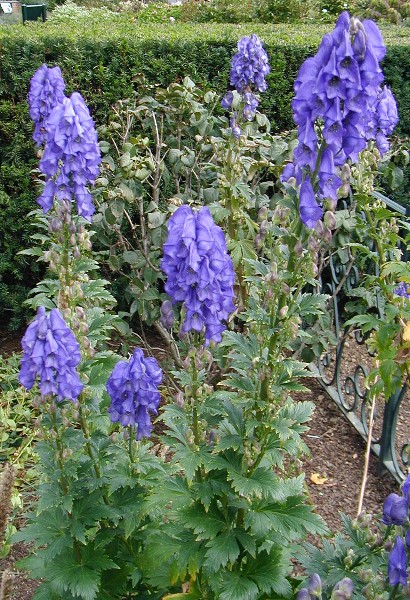
raises its spikes of slate / smoke blue hooded flowers, said to resemble the cowled hoods that monks once wore.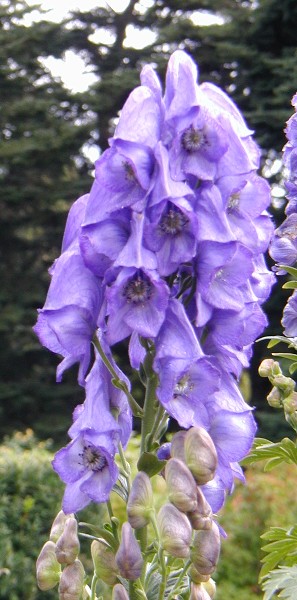
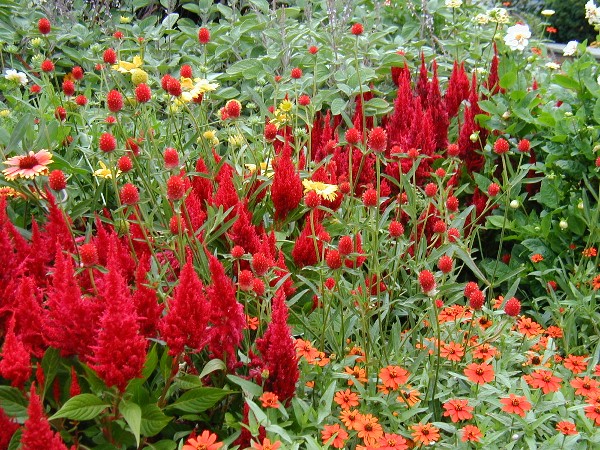
vivid red celosia, softer rose-red gomphrena, little orange zinnias, and the bolder daisies of gaillardia.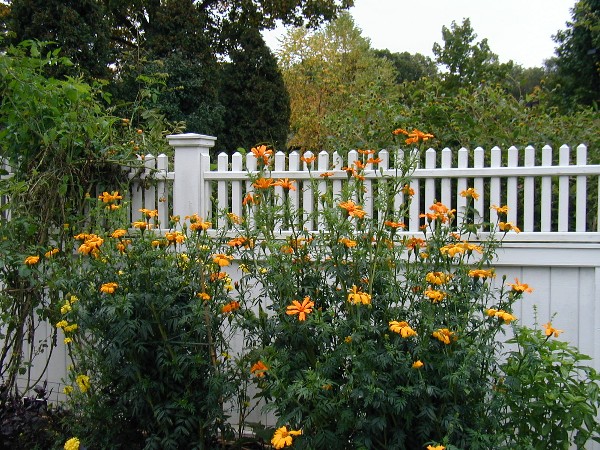
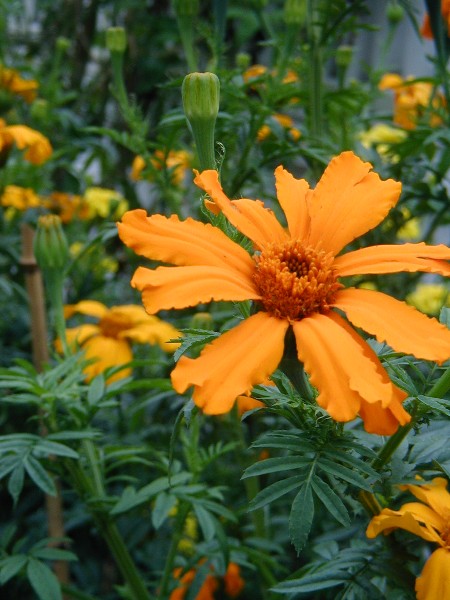
not one of the highly bred cultivars so familiar in gardens.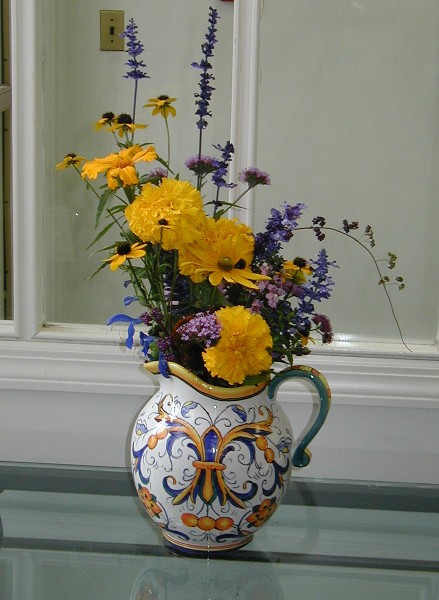
with a casual-seeming handful of flowers from the garden.
Deceptively simple, for the marigolds and rudbeckia, blue to lavender salvias and verbena
perfectly mirror the colors of their container. Attention to detail . . .
